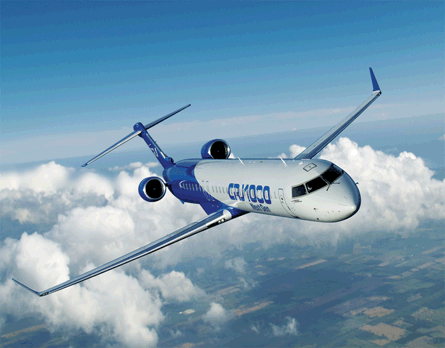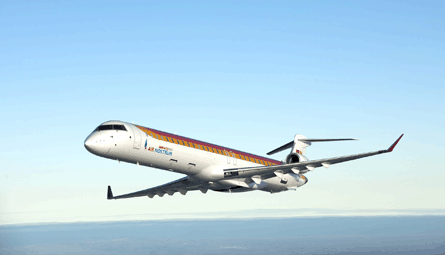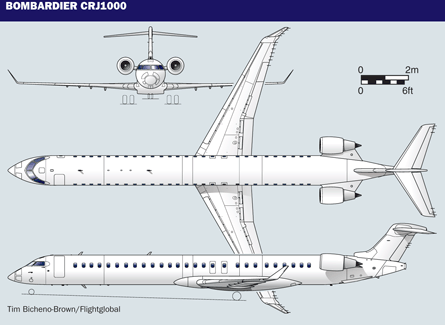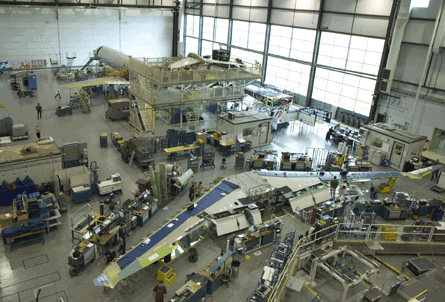Like the little sister who has grown taller than her older siblings, Bombardier's 100-seat CRJ1000 NextGen regional jet is both the latest and biggest member of the CRJ series, but retains many of the physical characteristics of its relatives.
At a length of 39.1m (128ft), the CRJ1000 represents a 2.9m stretch of the CRJ900 and features a 7.5% trailing-edge extension over its 88-seat predecessor, a 0.66m wing-tip extension, reinforced landing gear and carbon, instead of steel, brakes.
This is Bombardier's last exercise in elongating the CRJ, which began life in 1989 when the Canadian airframer stretched its Challenger business jet to produce the General Electric CF34-powered CRJ100.
 |
|---|
© Bombardier |
With an upgrade to a more efficient version of the CF34 engine, the 50-seater graduated to the CRJ200 and quickly became a regional airline workhorse that helped to form the backbone of the hub-and-spoke system in the USA. No longer produced for the commercial market, the CRJ200 spawned the 70-seat CRJ700 and the CRJ900.
In developing the new CRJ1000 around the 2007 timeframe, Bombardier opted to introduce an all-new "NextGen" cabin, with bigger passenger windows, overhead bins modified to store more luggage and LED lighting to brighten the cabin and highlight a new sidewall and ceiling-panel design. The NextGen's distinctive cabin features were then incorporated into the CRJ700 and CRJ900.
All three aircraft share CF34-8C5 powerplant commonality, although the CRJ1000 has, as basic, a normal take-off +2% to supply 13,630lb of thrust (60kN) with an optional +5% (see engine chart).
"The family concept is something that is also driving all of our design. We're evolving the design, we're not redoing it," says Jean-Guy Blondin, Bombardier CRJ programmes director.
With the CRJ1000 - which, like its sisters, is equipped with Rockwell Collins Pro Line 4 integrated cockpit avionics - Bombardier was "able to maintain the same type rating for pilots and the same maintenance training course" as the other CRJs, Blondin notes. "There are a few differences, but it's very, very simple to migrate to the new airplane if you're already a certified mechanic or a certified pilot. There is very little learning required. So that also helps airlines introduce a new type in their fleet and reduce their costs," he adds.
That is not to say the Canadian airframer has not made changes and improvements with the latest member of the CRJ family. "We've taken the opportunity of developing the CRJ1000 to bring a few new technologies into the aircraft," Blondin says.
 |
|---|
© BombardierBombardier operates a single, standardised manufacturing line for CRJs |
Most notably, instead of the hydro-mechanical rudder system found on the CRJ700/900, a control-by-wire system has been selected for the CRJ1000. The system, supplied by Germany's Liebherr Aerospace, was the subject of a software glitch in 2009, which delayed certification of the aircraft. However, Bombardier fixed the issue and the aircraft entered service in December 2010 with launch customer Air Nostrum and Air France subsidiary Brit Air.
"We learned a few things with our command-by-wire system on the CRJ1000," Gary Scott, president of Bombardier Commercial Aircraft, says. "The bottom line is we had some software challenges and so you learn about writing software and how the different [software] programs relate to one another."
Since the CRJ1000 entered service it had been "delivering on all fronts," Blondin adds.
Air Nostrum, a regional affiliate to Iberia, agrees with Bombardier's assessment, telling Flight International: "Management is very pleased with the performance to date, recognising the aircraft have accumulated very little hours yet. Same applies to the economics - so far so good. The reliability is very high and no relevant snags have been detected."
DELAY
The carrier admits the delay had a negative impact on its plans "but we have managed to minimise it together with Bombardier. We are replacing 50-seaters with the CRJ1000 as it has much better cost per seat, so we can better compete in our low-yield environment."
Bombardier is considering modifying the hydro-mechanical rudder system in the CRJ700 and CRJ900 to the control-by-wire system used in the CRJ1000. Blondin notes that what has been learned while implementing the CRJ1000 will help reduce technical risk on the airframer's all-new, 110- to 130-seat Pratt & Whitney-geared turbofan-powered CSeries, which "will be a fully three-axis" fly-by-wire-controlled aircraft.
Another new feature for the CRJ1000, he says, is the CMC Electronics-provided dual electronic flight bag systems. Blondin says: "It's a Class 2 EFB that is mounted on each side of the cockpit, but removable. We've also developed an aircraft performance package that, if [operators] elect, they could load on to the computer and they can do aircraft performance calculations quicker and with more precision than having to look at quick reference books and pages of data."
 |
|---|
© BombardierThe CRJ1000 entered service in December 2010 with launch customer Air Nostrum |
On the flightdeck, the CRJ1000 boasts LCD screens for the newest configuration of the flight management system and digital radios. Coupled vertical navigation is deployed as part of the CRJ1000 programme and is now available as an optional feature on the CRJ700 and CRJ900.
"We've been working a lot on the FMS capability and also on lateral navigation precision, but we are still working on the vertical aspect of the flightpath," Blondin says.
"More and more today in the airspace environment, accurate guidance of the airplane in following a lateral track - but also vertical guidance to precise crossing altitudes waypoints - becomes extremely critical.
"In other words, you have both a left/right deviation as well as a higher or lower deviation, where the aircraft can accurately be at any point in that three-dimensional spectrum. The air traffic controllers will issue a clearance and command: 'We want you at that waypoint place at 5,000ft', then the FMS system and autopilot guides the airplane and takes you to exactly that point at 5,000ft, fully automated.
"So the fact that you have more precision now in the newer-generation airplanes in your ability to properly place your aircraft in space, has allowed air traffic to reduce spacing and increase capacity into and out of airports," Blondin says.
 |
|---|
An option for the CRJ1000, and also now for the CRJ900 and CRJ700, is the wide area augmentation system (WAAS) and localiser performance with vertical guidance (LPV) solution for precision approach navigation.
"By doing a WAAS-based system you increase the accuracy of the lateral and vertical navigation capability of the airplane," Blondin says. "This allows us to certify LPV approaches, which enables instrument landing system-like approaches in an airport. So we are recreating the same capability in the airplane using the satellites as you had with the ground-based systems. In effect, working with the Federal Aviation Administration guidelines for the next-gen [air traffic control] system, which will be much more dependent on satellite-based navigation than on the ground-based equipment.
"So as you can see, we're evolving the platform to be able to handle any of the new navigation capabilities that are being developed.
"The other thing we've done as an option for the CRJ1000, which we had already done on the CRJ700/900, is the head-up guidance system with Cat IIIa capability. It's being certified as we speak," Blondin adds.
CONFIGURATIONS
Apart from the now standard NextGen cabin features offered across the CRJ700/900/1000 line, the CRJ1000 is available in single- and dual-class configuration, with a 31in (79cm) pitch for seats in economy class.
Seats manufactured by C&D Zodiac and B/E Aerospace are offered line-fit on the CRJ1000. "It's a customer's selection," Blondin says, confirming that if a carrier wants a seat outside the catalogue it must do so via retrofit. In-flight entertainment is an optional feature for the CRJ1000. "It's an individually mounted, seat-back TV screen with audio/video on demand," Blondin says.
 |
|---|
Click for full size image |
In the future, Bombardier expects to offer in-flight wi-fi on its CRJs. "Being able to access the internet from your own device, in our view, seems to be much more in demand than just watching TV or reruns. I think that's where the future is at, because people can stay connected to the office using their computer or they can surf the internet and do what they want. So the internet approach offers a lot more value to the public," Blondin says.
Bombardier operates a single, standardised manufacturing line for the CRJ700, CRJ900 and CRJ1000 at its Mirabel facility outside Montreal, with a 66-day production cycle from join to customer delivery. "We can build any number of CRJ700s, CRJ900s and CRJ1000s in any quantity the customer may want, " Blondin says.
The CRJ1000 has attracted 49 orders - 35 from Air Nostrum and 15 from Brit Air - and Bombardier is optimistic it will secure more orders for the type. The aircraft offers "between 5% and 7% lower direct operating cost than competing jets," alongside the "enhanced comfort of the NextGen cabin and a reduced environmental impact with low fuel burn", Blondin says, adding that the manufacturer is having "good discussions" about CRJ1000 orders.
Blondin says the 49 orders makes it the airframer's most successful launch. However, pilot scope clause constraints in the USA have made it difficult for Bombardier to break the CRJ1000 into the US market.
 |
|---|
© BombardierBombardier operates a single, standardised manufacturing line for the CRJ700, CRJ900 and CRJ1000 at its Mirabel facility outside Montreal |
"We saw this as the final edition, the final piece to our CRJ family," Scott says. "The market segment for it is several hundred, so it's more of a niche airplane. Obviously it doesn't work well in the United States because of the scope limitations, but it does work well in Europe and in other parts of the world, so we're optimistic," he adds.
Roger Cohen, president of US regional airline lobbying group the Regional Airline Association, also expresses confidence that the CRJ1000 will eventually take to US skies.
"[These days] it's hard to describe what's a regional airline, what's not a regional airline [and] what's a mainline aircraft," he says. "Those lines, if they were ever in existence before, have been blurred, if not obliterated, and it continuously changes."
Source: Flight International



















